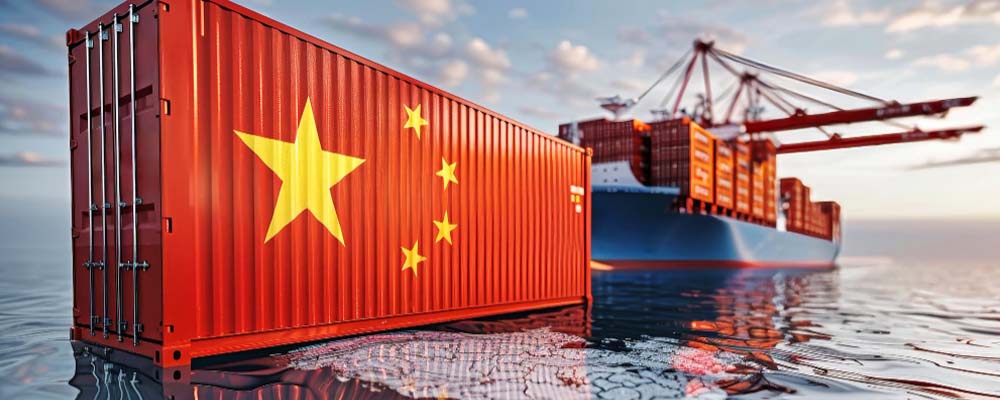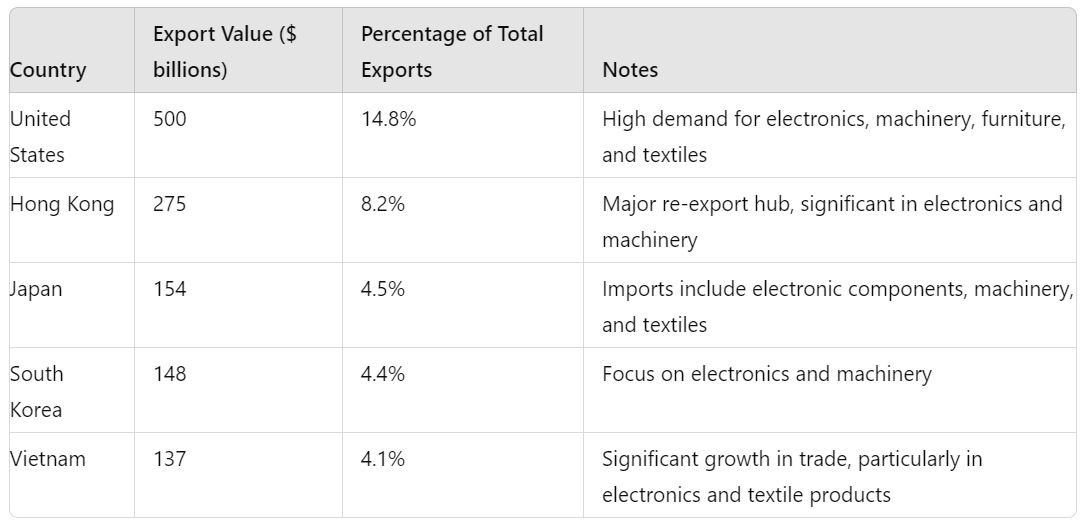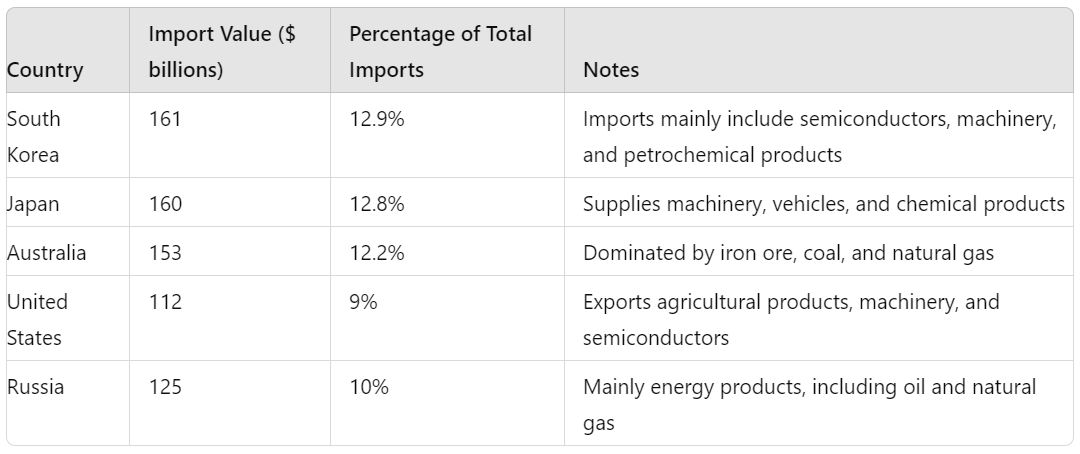
China’s role as a global trading giant is exemplified by its extensive network of export and import partners. This blog post delves into the key countries involved in trade with China and the main commodities exchanged.
 Top Export Partners
Top Export Partners
- United States
- Value: $500 billion
- Percentage of Total Exports: 14.8%
- The United States remains the largest recipient of Chinese goods, with key exports including electronics, machinery, furniture, and textiles.
- Hong Kong
- Value: $275 billion
- Percentage of Total Exports: 8.2%
- Serving as a critical re-export hub, Hong Kong’s trade with mainland China involves significant volumes of electronics and machinery.
- Japan
- Value: $154 billion
- Percentage of Total Exports: 4.5%
- Japan’s imports from China largely consist of electronic components, machinery, and textiles.
- South Korea
- Value: $148 billion
- Percentage of Total Exports: 4.4%
- South Korea imports a range of goods from China, including electronics, chemicals, and machinery.
- Vietnam
- Value: $137 billion
- Percentage of Total Exports: 4.1%
- Vietnam has seen rapid growth in trade with China, particularly in electronics and textile products.
 Top Import Partners
Top Import Partners
- South Korea
- Value: $161 billion
- Percentage of Total Imports: 12.9%
- South Korea exports a significant amount of semiconductors, machinery, and petrochemical products to China.
- Japan
- Value: $160 billion
- Percentage of Total Imports: 12.8%
- China’s imports from Japan include machinery, vehicles, and chemical products.
- Australia
- Value: $153 billion
- Percentage of Total Imports: 12.2%
- Australia is a major supplier of iron ore, coal, and natural gas to China.
- United States
- Value: $112 billion
- Percentage of Total Imports: 9%
- Despite geopolitical tensions, the United States supplies agricultural products, machinery, and semiconductors to China.
- Russia
- Value: $125 billion
- Percentage of Total Imports: 10%
- Russia’s exports to China are dominated by energy products, including oil and natural gas.
Trade Deficits and Surpluses
China’s trade balance showcases both its strengths and areas of challenge. The country achieved a substantial overall trade surplus of $880 billion, underpinned by significant surpluses with the United States ($388 billion), Hong Kong ($137 billion), and Japan ($67 billion), primarily due to high exports of electronics, machinery, and textiles. However, China also faced notable trade deficits, particularly with South Korea ($13 billion), Australia ($12 billion), and Russia ($7 billion), driven by imports of semiconductors, raw materials, and energy products. This balance underscores China’s crucial role in global trade as both a major exporter and importer of essential goods.
Continental Trade Distribution
A significant portion of China’s trade is concentrated within Asia, with approximately 47.8% of exports and 54.3% of imports involving Asian countries. This is followed by notable trade volumes with North America, accounting for 18.9% of exports and 14.3% of imports. Europe also plays a crucial role in China’s trade, comprising 19.2% of exports and 17.6% of imports. This distribution highlights China’s strategic economic ties across multiple continents, underscoring its integrated role in global trade networks.
Emerging Markets and New Partnerships
Emerging markets are becoming increasingly important in China’s trade portfolio. Countries like India and Indonesia are witnessing rapid industrial growth and becoming notable destinations for Chinese exports, including electronics and machinery. At the same time, these markets supply China with vital raw materials and agricultural products. New partnerships are also being forged through initiatives like the Belt and Road Initiative (BRI), which aims to enhance trade routes and economic ties across Asia, Africa, and Europe, paving the way for future trade growth.
Sustainable Trade Practices
Sustainability is becoming a cornerstone of contemporary trade practices, and China is making strides in this direction. The country is investing heavily in green technologies and renewable energy sources such as wind, solar, and hydroelectric power. These investments not only reduce the carbon footprint of China’s industrial activities but also stimulate the trade of eco-friendly products. Additionally, China is collaborating with global partners to implement sustainable practices in supply chain management, ensuring that environmental considerations are integrated into trade operations.
Technological Innovations
Technological advancements are revolutionizing the landscape of global trade, and China stands at the forefront of this transformation. The adoption of artificial intelligence (AI), big data analytics, and blockchain technology is streamlining supply chain processes, enhancing efficiency, and reducing costs. These innovations allow for better tracking of goods, improved inventory management, and more precise demand forecasting. China’s investment in tech-driven trade infrastructure is not only modernizing its own economy but also setting new standards in international commerce.
Government Initiatives
Government policies and initiatives play a pivotal role in shaping China’s trade environment. The Chinese government actively fosters trade through various incentive programs, strategic trade agreements, and economic reforms. Policies like the Made in China 2025 plan aim to upgrade the manufacturing sector by promoting high-tech industries and reducing reliance on foreign technology. Additionally, free trade zones (FTZs) across the country provide tax incentives and regulatory advantages to attract foreign investment and facilitate international trade.
Conclusion
China’s trade relationships underscore its vital role in the global economy, with extensive networks of export and import partners. Concentrating significant trade in Asia and engaging robustly with North America and Europe, China emphasizes its integral position in global trade. Emerging markets, supported by initiatives like the Belt and Road Initiative, and the country’s commitment to sustainable practices and technological innovations, set new standards in international commerce.
Government initiatives such as the Made in China 2025 plan and free trade zones play a crucial role in fostering trade through incentives and strategic agreements. As global trade dynamics evolve, China’s adaptability and strengthened trade policies are essential for its economic resilience. Connecta can assist businesses in navigating China’s trade landscape by providing networking, resources, and logistical support, ensuring smooth transactions and enhanced global reach.




 Top Export Partners
Top Export Partners Top Import Partners
Top Import Partners





